 | –≠–ª–µ–∫—Ç—Ä–æ–Ω–Ω—ã–π –∫–æ–º–ø–æ–Ω–µ–Ω—Ç: PCM1803 | –°–∫–∞—á–∞—Ç—å:  PDF PDF  ZIP ZIP |
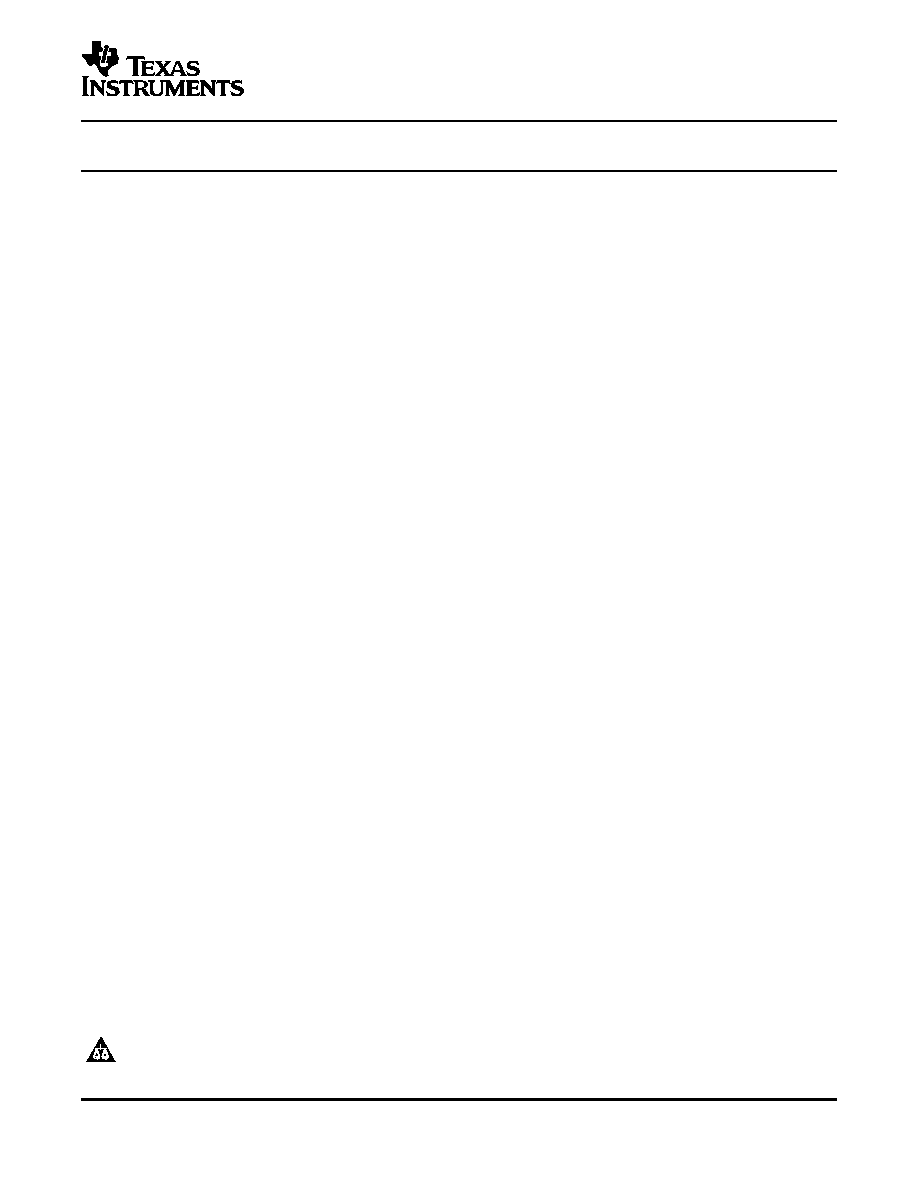
www.ti.com
FEATURES
APPLICATIONS
DESCRIPTION
PCM1803
SLES125 ≠ NOVEMBER 2004
SINGLE-ENDED, ANALOG-INPUT 24-BIT, 96-kHz STEREO A/D CONVERTER
∑
AV Amplifier Receiver
∑
24-Bit Delta-Sigma Stereo A/D Converter
∑
MD Player
∑
Single-Ended Voltage Input: 3 Vp-p
∑
CD Recorder
∑
Oversampling Decimation Filter:
∑
Multitrack Receiver
≠ Oversampling Frequency:
◊
64,
◊
128
∑
Electric Musical Instrument
≠ Pass-Band Ripple:
±
0.05 dB
≠ Stop-Band Attenuation: ≠65 dB
≠ On-Chip High-Pass Filter: 0.84 Hz (44.1 kHz)
The
PCM1803
is
high-performance,
low-cost,
∑
High-Performance:
single-chip stereo analog-to-digital converter with
≠ THD+N: ≠95 dB (Typically)
single-ended analog voltage input. The PCM1803
uses a delta-sigma modulator with 64-, 128-times
≠ SNR: 103 dB (Typically)
oversampling, and includes a digital decimation filter
≠ Dynamic Range: 103 dB (Typically)
and
high-pass
filter
which
removes
the
DC
∑
PCM Audio Interface:
component of the input signal. For various appli-
cations, the PCM1803 supports master and slave
≠ Master/Slave Mode Selectable
modes and four data formats in serial interface. The
≠ Data Formats:
PCM1803
is
suitable
for
a
wide
variety
of
∑
24-Bit Left-Justified
cost-sensitive consumer applications where good per-
formance and operation from a 5-V analog supply
∑
24-Bit I
2
S
and 3.3-V digital supply are required. The PCM1803
∑
20-, 24-Bit Right-Justified
is fabricated using a highly advanced CMOS process
∑
Sampling Rate: 16 kHz to 96 kHz
and is available in a small 20-pin SSOP package.
∑
System Clock: 256 f
S
, 384 f
S
, 512 f
S
, 768 f
S
∑
Dual Power Supplies: 5 V for Analog, 3.3 V for
Digital
∑
Package: 20-Pin SSOP
∑
Pb-Free Product
Please be aware that an important notice concerning availability, standard warranty, and use in critical applications of Texas
Instruments semiconductor products and disclaimers thereto appears at the end of this data sheet.
System Two, Audio Precision are trademarks of Audio Precision, Inc.
All other trademarks are the property of their respective owners.
PRODUCTION DATA information is current as of publication date.
Copyright © 2004, Texas Instruments Incorporated
Products conform to specifications per the terms of the Texas
Instruments standard warranty. Production processing does not
necessarily include testing of all parameters.

www.ti.com
PIN ASSIGNMENTS
1
2
3
4
5
6
7
8
9
10
20
19
18
17
16
15
14
13
12
11
V
IN
L
V
IN
R
V
REF
1
V
REF
2
V
CC
AGND
PDWN
BYPAS
TEST
LRCK
MODE1
MODE0
FMT1
FMT0
OSR
SCKI
V
DD
DGND
DOUT
BCK
PCM1803
(TOP VIEW)
P0009-01
BLOCK DIAGRAM
BCK
V
IN
L
Reference
V
REF
1
V
REF
2
V
IN
R
Delta-Sigma
Modulator
Delta-Sigma
Modulator
◊
1/64 ,
◊
1/128
Decimation
Filter
With
High-Pass Filter
Power Supply
AGND
V
CC
V
DD
DGND
Clock and Timing Control
Serial
Interface
Mode/
Format
Control
LRCK
DOUT
FMT0
FMT1
MODE0
MODE1
BYPAS
OSR
PDWN
SCKI
B0004-06
TEST
PCM1803
SLES125 ≠ NOVEMBER 2004
This integrated circuit can be damaged by ESD. Texas Instruments recommends that all integrated
circuits be handled with appropriate precautions. Failure to observe proper handling and installation
procedures can cause damage.
ESD damage can range from subtle performance degradation to complete device failure. Precision
integrated circuits may be more susceptible to damage because very small parametric changes could
cause the device not to meet its published specifications.
ORDERING INFORMATION
PRODUCT
PACKAGE
PACKAGE
PACKAGE
ORDERING
TRANSPORT
QUANTITY
CODE
MARKING
NUMBER
MEDIA
PCM1803DB
Tube
65
PCM1803DB
20-Pin SSOP
DB
PCM1803
PCM1803DBR
Tape and Reel
2000
2
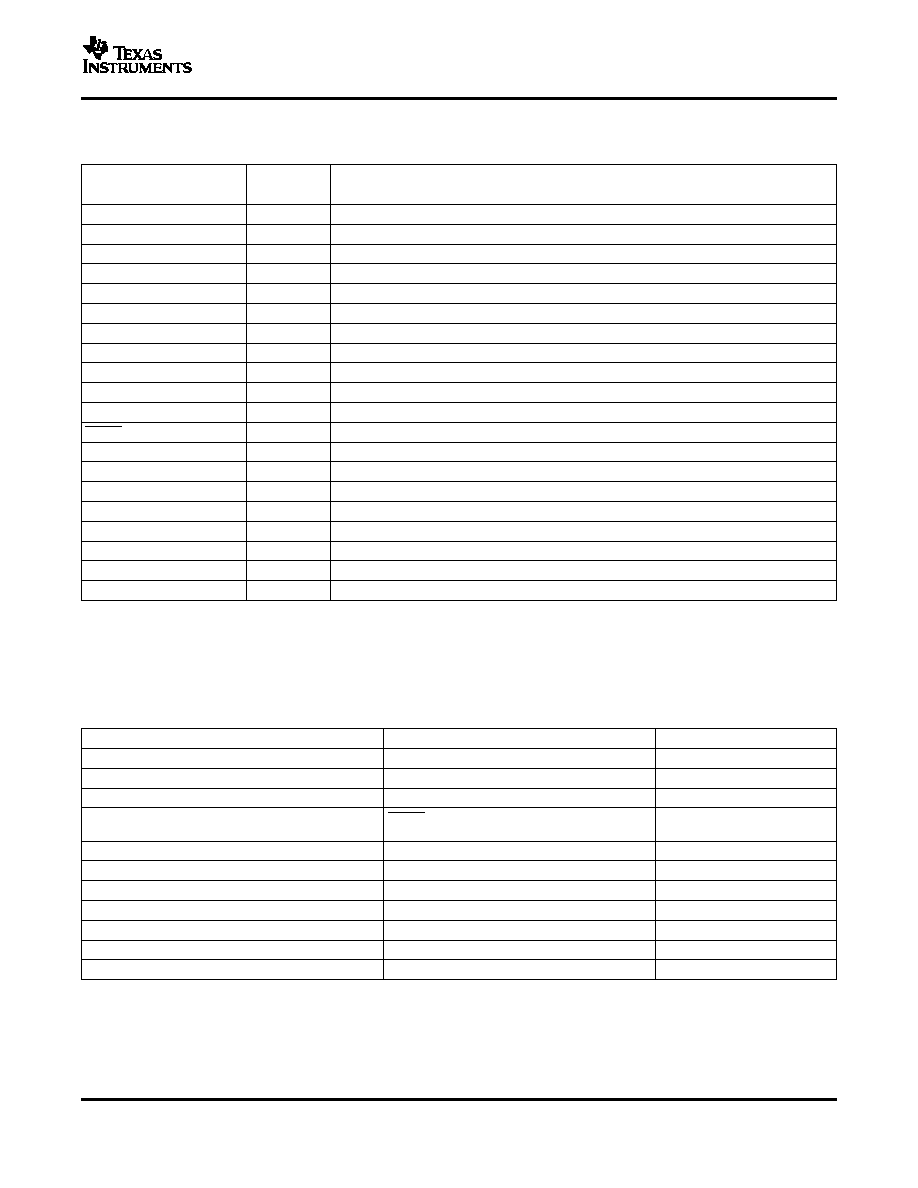
www.ti.com
DEVICE INFORMATION
ABSOLUTE MAXIMUM RATINGS
PCM1803
SLES125 ≠ NOVEMBER 2004
TERMINAL FUNCTIONS
TERMINAL
I/O
DESCRIPTION
NAME
NO.
AGND
6
≠
Analog GND
BCK
11
I/O
Audio data bit clock input/output
(1)
BYPAS
8
I
HPF bypass control. LOW: Normal mode (dc reject); HIGH: Bypass mode (through)
(2)
DGND
13
≠
Digital GND
DOUT
12
O
Audio data digital output
FMT0
17
I
Audio data format select input 0. See Data Format section.
(2)
FMT1
18
I
Audio data format select input 1. See Data Format section.
(2)
LRCK
10
I/O
Audio data latch enable input/output
(1)
MODE0
19
I
Mode select input 0. See Data Format section.
(2)
MODE1
20
I
Mode select input 1. See Data Format section.
(2)
OSR
16
I
Oversampling ratio select input. LOW:
◊
64 f
S
, HIGH:
◊
128 f
S
(2)
PDWN
7
I
Power-down control, active-low
(2)
SCKI
15
I
System clock input: 256 f
S
, 384 f
S
, 512 f
S
or 768 f
S
(3)
TEST
9
I
Test, must be connected to DGND
(2)
V
CC
5
≠
Analog power supply, 5-V
V
DD
14
≠
Digital power supply, 3.3-V
V
IN
L
1
I
Analog input, L-channel
V
IN
R
2
I
Analog input, R-channel
V
REF
1
3
≠
Reference-voltage-1 decoupling capacitor
V
REF
2
4
≠
Reference-voltage-2 decoupling capacitor
(1)
Schmitt-trigger input
(2)
Schmitt-trigger input with internal pulldown (50 k
typically), 5-V tolerant
(3)
Schmitt-trigger input, 5-V tolerant
over operating free-air temperature range (unless otherwise noted)
(1)
Supply voltage
V
CC
≠0.3 V to 6.5 V
Supply voltage
V
DD
≠0.3 V to 4 V
Ground voltage differences
AGND, DGND
±
0.1 V
Digital input voltage, V
I
LRCK, BCK, DOUT
≠0.3 V to (V
DD
+ 0.3 V) < 4 V
Digital input voltage, V
I
PDWN, BYPAS, TEST, SCKI, OSR, FMT0,
≠0.3 V to 6.5 V
FMT1, MODE0, MODE1
Analog input voltage, V
I
V
IN
L, V
IN
R, V
REF
1, V
REF
2
≠0.3 V to (V
CC
+ 0.3 V) < 6.5 V
Input current, I
I
Any pins except supplies
±
10 mA
Ambient temperature under bias, T
bias
≠40
∞
C to 125
∞
C
Storage temperature, T
stg
≠55
∞
C to 150
∞
C
Junction temperature, T
J
150
∞
C
Lead temperature (soldering)
260
∞
C, 5 s
Package temperature (IR reflow, peak)
260
∞
C
(1)
Stresses beyond those listed under "absolute maximum ratings" may cause permanent damage to the device. These are stress ratings
only and functional operation of the device at these or any other conditions beyond those indicated under "recommended operating
conditions" is not implied. Exposure to absolute-maximum-rated conditions for extended periods may affect device reliability.
3

www.ti.com
RECOMMENDED OPERATING CONDITIONS
ELECTRICAL CHARACTERISTICS
PCM1803
SLES125 ≠ NOVEMBER 2004
over operating free-air temperature range
MIN
NOM
MAX
UNIT
Analog supply voltage, V
CC
4.5
5
5.5
V
Digital supply voltage, V
DD
2.7
3.3
3.6
V
Analog input voltage, full-scale (≠0 dB)
3
Vp-p
Digital input logic family
TTL
System clock
8.192
49.152
MHz
Digital input clock frequency
Sampling clock
32
96
kHz
Digital output load capacitance
10
pF
Operating free-air temperature, T
A
≠25
85
∞
C
All specifications at T
A
= 25
∞
C, V
CC
= 5 V, V
DD
= 3.3 V, master mode, f
S
= 44.1 kHz, system clock = 384 f
S
,
oversampling ratio =
◊
128, 24-bit data (unless otherwise noted)
PARAMETER
TEST CONDITIONS
MIN
TYP
MAX
UNIT
Resolution
24
Bits
DATA FORMAT
Audio data interface format
Left-justified, I
2
S, right-justified
Audio data bit length
20, 24
Bits
Audio data format
MSB-first, 2s complement
f
S
Sampling frequency
16
44.1
96
kHz
256 f
S
4.096
11.2896
24.576
384 f
S
6.144
16.9344
36.864
System clock frequency
MHz
512 f
S
8.192
22.5792
49.152
768 f
S
12.288
33.8688
≠
INPUT LOGIC
V
IH
(1)
2
V
DD
V
IL
(1)
0
0.8
Input logic-level voltage
VDC
V
IH
(2) (3)
2
5.5
V
IL
(2) (3)
0
0.8
I
IH
(1) (2)
V
IN
= V
DD
±
10
I
IL
(1) (2)
V
IN
= 0
±
10
Input logic-level current
µ
A
I
IH
(3)
V
IN
= V
DD
65
100
I
IL
(3)
V
IN
= 0
±
10
OUTPUT LOGIC
V
OH
(4)
I
OUT
= ≠4 mA
2.8
Output logic-level voltage
VDC
V
OL
(4)
I
OUT
= 4 mA
0.5
DC ACCURACY
Gain mismatch, channel-to-channel
±
1
±
3
% of FSR
Gain error
±
2
±
4
% of FSR
Bipolar zero error
HPF bypass
±
0.4
% of FSR
(1)
Pins 10≠11: LRCK, BCK (Schmitt-trigger input, in slave mode)
(2)
Pin 15: SCKI (Schmitt-trigger input, 5-V tolerant)
(3)
Pins 7≠9, 16≠20: PDWN, BYPAS, TEST, OSR, FMT0, FMT1, MODE0, MODE1 (Schmitt-trigger input, with 50-k
typical pulldown
resistor, 5-V tolerant)
(4)
Pins 10≠12: LRCK, BCK (in master mode), DOUT
4
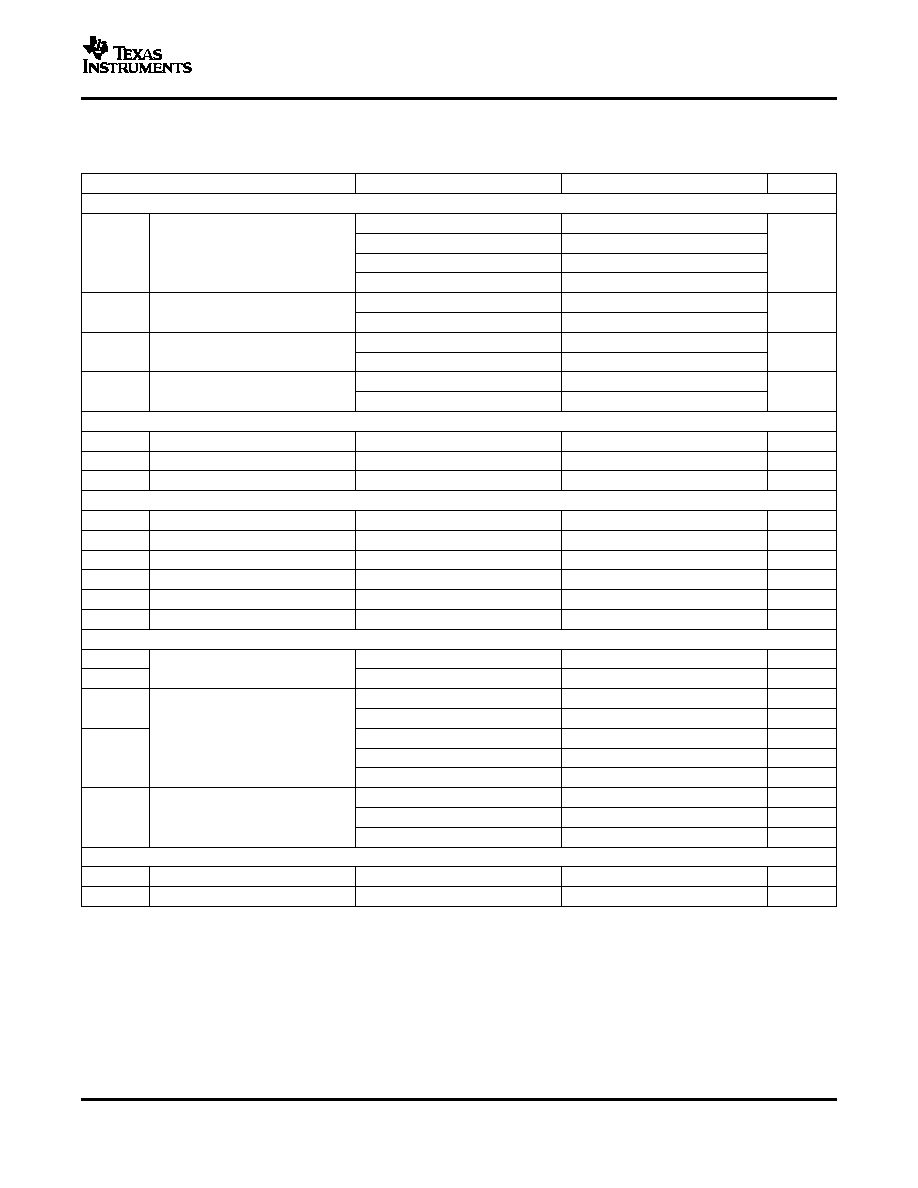
www.ti.com
PCM1803
SLES125 ≠ NOVEMBER 2004
ELECTRICAL CHARACTERISTICS (continued)
All specifications at T
A
= 25
∞
C, V
CC
= 5 V, V
DD
= 3.3 V, master mode, f
S
= 44.1 kHz, system clock = 384 f
S
,
oversampling ratio =
◊
128, 24-bit data (unless otherwise noted)
PARAMETER
TEST CONDITIONS
MIN
TYP
MAX
UNIT
DYNAMIC PERFORMANCE
(5)
V
IN
= ≠0.5 dB, f
S
= 44.1 kHz
≠95
≠89
V
IN
= ≠0.5 dB, f
S
= 96 kHz
(6)
≠93
THD+N
Total harmonic distortion + noise
dB
V
IN
= ≠60 dB, f
S
= 44.1 kHz
≠41
V
IN
= ≠60 dB, f
S
= 96 kHz
(6)
≠41
f
S
= 44.1 kHz, A-weighted
100
103
Dynamic range
dB
f
S
= 96 kHz, A-weighted
(6)
103
f
S
= 44.1 kHz, A-weighted
100
103
SNR
Signal-to-noise ratio
dB
f
S
= 96 kHz, A-weighted
(6)
103
f
S
= 44.1 kHz
95
98
Channel separation
dB
f
S
= 96 kHz
(6)
99
ANALOG INPUT
V
I
Input voltage
0.6 V
CC
Vp-p
Center voltage (V
REF
1)
0.5 V
CC
V
Input impedance
40
k
DIGITAL FILTER PERFORMANCE
Pass band
0.431 f
S
Hz
Stop band
0.569 f
S
Hz
Pass-band ripple
±
0.05
dB
Stop-band attenuation
≠65
dB
t
GD
Group delay time
17.4/f
S
s
HPF frequency response
≠3 dB
0.019 f
S
mHz
POWER SUPPLY REQUIREMENTS
V
CC
4.5
5
5.5
VDC
Supply voltage range
V
DD
2.7
3.3
3.6
VDC
I
CC
7.7
10
mA
Power down
(8)
5
µ
A
I
DD
Supply current
(7)
f
S
= 44.1 kHz
6.5
9
mA
f
S
= 96 kHz
(6)
11.7
mA
Power down
(8)
1
µ
A
f
S
= 44.1 kHz
60
80
mW
Power dissipation
f
S
= 96 kHz
(6)
77
mW
Power down
(8)
28
µ
W
TEMPERATURE RANGE
T
A
Operating free-air temperature
≠40
85
∞
C
JA
Thermal resistance
20-Pin SSOP
115
∞
C/W
(5)
Analog performance specifications are tested using the System TwoTM audio measurement system by Audio PrecisionTM, using 400-Hz
HPF, 20-kHz LPF in rms mode.
(6)
f
S
= 96 kHz, system clock = 256 f
S
, oversampling ratio =
◊
64.
(7)
Minimum load on DOUT (pin 12), BCK (pin 11), LRCK (pin 10)
(8)
Halt SCKI, BCK, LRCK.
5

www.ti.com
TYPICAL PERFORMANCE CURVES OF INTERNAL FILTER
Decimation Filter Frequency Response
Normalized Frequency [
◊
f
S
]
-200
-150
-100
-50
0
50
0
8
16
24
32
40
48
56
64
Oversampling Ratio =
y
128
Amplitude - dB
G001
G002
Normalized Frequency [
◊
f
S
]
-200
-150
-100
-50
0
50
0
8
16
24
32
Amplitude - dB
Oversampling Ratio =
y
64
G003
Normallized Frequency [
◊
f
S
]
-100
-90
-80
-70
-60
-50
-40
-30
-20
-10
0
0.00
0.25
0.50
0.75
1.00
Amplitude - dB
Oversampling
Ratio =
y
128 and
y
64
G004
Normalized Frequency [
◊
f
S
]
-1.0
-0.8
-0.6
-0.4
-0.2
0.0
0.2
0.0
0.1
0.2
0.3
0.4
0.5
0.6
Amplitude - dB
Oversampling
Ratio =
y
128 and
y
64
PCM1803
SLES125 ≠ NOVEMBER 2004
All specifications at T
A
= 25
∞
C, V
CC
= 5 V, V
DD
= 3.3 V, master mode, f
S
= 44.1 kHz, system clock = 384 f
S
,
oversampling ratio =
◊
128, 24-bit data, unless otherwise noted
OVERALL CHARACTERISTICS
OVERALL CHARACTERISTICS
Figure 1.
Figure 2.
STOP-BAND ATTENUATION CHARACTERISTICS
PASS-BAND RIPPLE CHARACTERISTICS
Figure 3.
Figure 4.
6
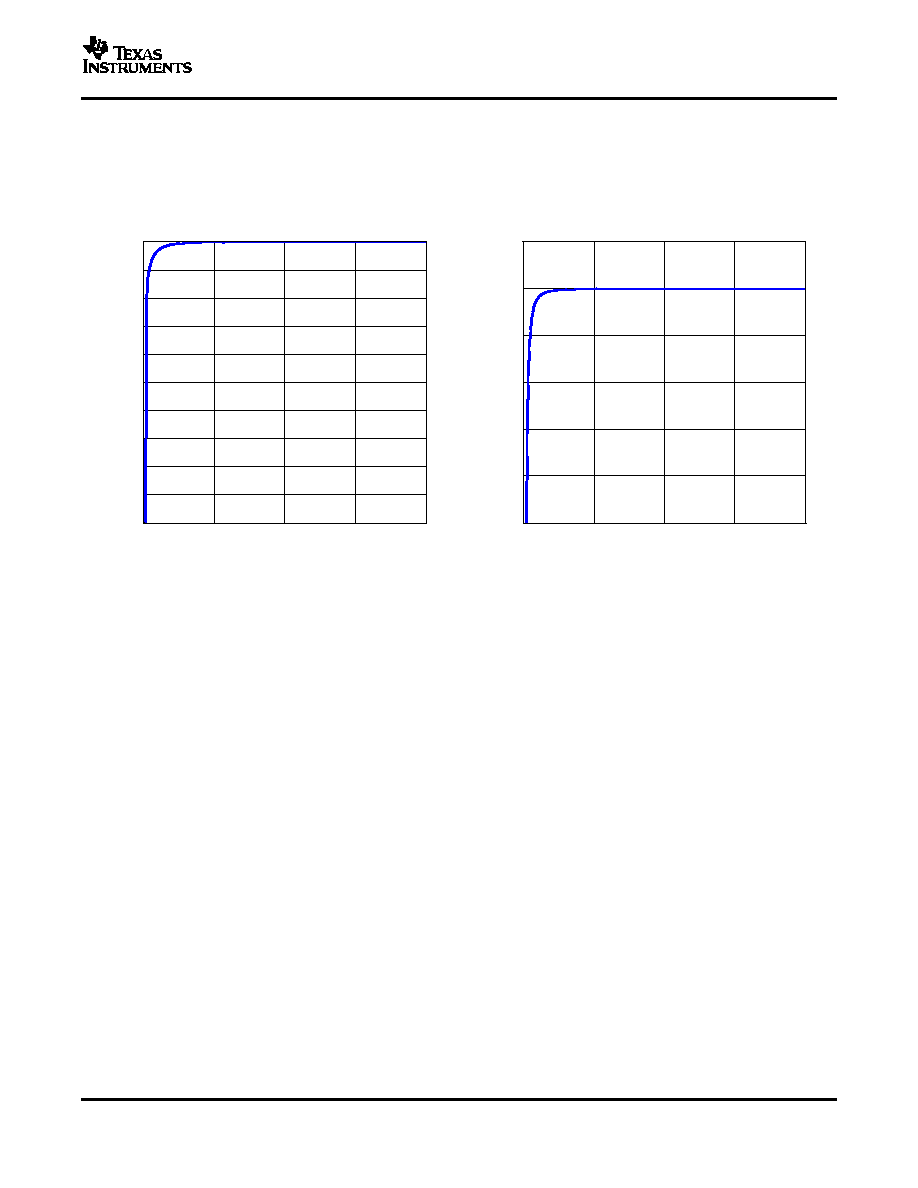
www.ti.com
LOW-CUT FILTER FREQUENCY RESPONSE
G005
Normalized Frequency [
◊
f
S
/1000]
-100
-90
-80
-70
-60
-50
-40
-30
-20
-10
0
0.0
0.1
0.2
0.3
0.4
Amplitude - dB
G006
Normalized Frequency [
◊
f
S
/1000]
-1.0
-0.8
-0.6
-0.4
-0.2
0.0
0.2
0
1
2
3
4
Amplitude - dB
PCM1803
SLES125 ≠ NOVEMBER 2004
TYPICAL PERFORMANCE CURVES OF INTERNAL FILTER (continued)
All specifications at T
A
= 25
∞
C, V
CC
= 5 V, V
DD
= 3.3 V, master mode, f
S
= 44.1 kHz, system clock = 384 f
S
,
oversampling ratio =
◊
128, 24-bit data, unless otherwise noted
HPF STOP-BAND CHARACTERISTICS
HPF PASS-BAND CHARACTERISTICS
Figure 5.
Figure 6.
7
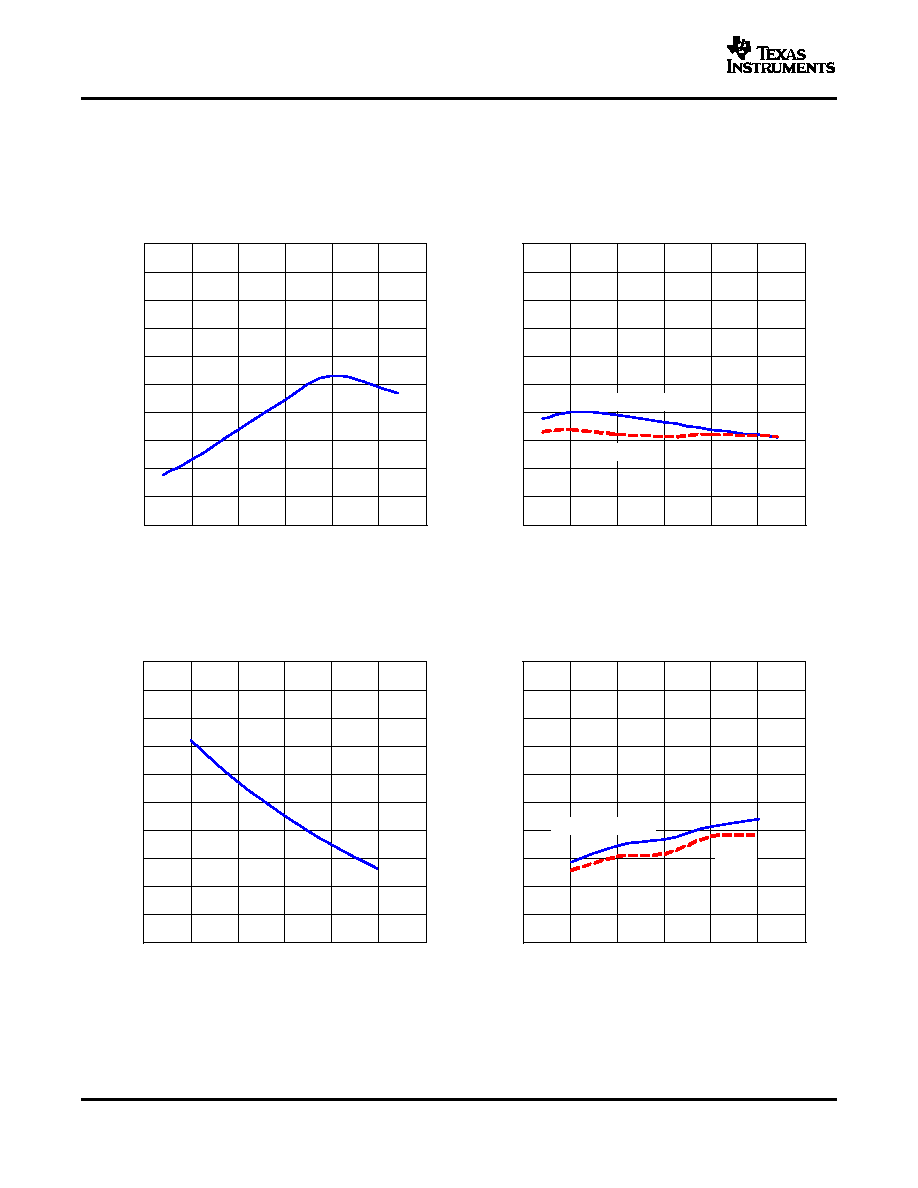
www.ti.com
TYPICAL PERFORMANCE CURVES
G007
-100
-99
-98
-97
-96
-95
-94
-93
-92
-91
-90
-50
-25
0
25
50
75
100
T
A
- Free-Air Temperature -
∞
C
THD+N - T
otal Harmonic Distortion + Noise - dB
100
101
102
103
104
105
106
107
108
109
110
-50
-25
0
25
50
75
100
G008
T
A
- Free-Air Temperature -
∞
C
Dynamic Range and SNR - dB
SNR
Dynamic Range
-100
-99
-98
-97
-96
-95
-94
-93
-92
-91
-90
4.25
4.50
4.75
5.00
5.25
5.50
5.75
V
CC
- Supply Voltage - V
THD+N - T
otal Harmonic Distortion + Noise - dB
G009
G010
100
101
102
103
104
105
106
107
108
109
110
4.25
4.50
4.75
5.00
5.25
5.50
5.75
V
CC
- Supply Voltage - V
Dynamic Range and SNR - dB
SNR
Dynamic Range
PCM1803
SLES125 ≠ NOVEMBER 2004
All specifications at T
A
= 25
∞
C, V
CC
= 5 V, V
DD
= 3.3 V, master mode, f
S
= 44.1 kHz, system clock = 384 f
S
,
oversampling ratio =
◊
128, 24-bit data, unless otherwise noted
TOTAL HARMONIC DISTORTION + NOISE
DYNAMIC RANGE and SIGNAL-TO-NOISE RATIO
vs
vs
TEMPERATURE
TEMPERATURE
Figure 7.
Figure 8.
TOTAL HARMONIC DISTORTION + NOISE
DYNAMIC RANGE and SIGNAL-TO-NOISE RATIO
vs
vs
SUPPLY VOLTAGE
SUPPLY VOLTAGE
Figure 9.
Figure 10.
8

www.ti.com
-100
-99
-98
-97
-96
-95
-94
-93
-92
-91
-90
0
10
20
30
40
f
SAMPLE
Condition - kHz
THD+N - T
otal Harmonic Distortion + Noise - dB
44.1
96
(2)
48
(1)
(1)
f
S
= 48 kHz, System Clock = 256 f
S
,
Oversampling Ratio =
◊
128.
(2)
f
S
= 96 kHz, System Clock = 256 f
S
,
Oversampling Ratio =
◊
64.
G011
100
101
102
103
104
105
106
107
108
109
110
0
10
20
30
40
Dynamic Range and SNR - dB
44.1
96
(2)
48
(1)
SNR
Dynamic Range
f
SAMPLE
Condition - kHz
(1)
f
S
= 48 kHz, System Clock = 256 f
S
,
Oversampling Ratio =
◊
128.
(2)
f
S
= 96 kHz, System Clock = 256 f
S
,
Oversampling Ratio =
◊
64.
G012
OUTPUT SPECTRUM
G013
f - Frequency - kHz
-140
-120
-100
-80
-60
-40
-20
0
0
5
10
15
20
Input Level = -0.5 dB
Data Points = 8192
Amplitude - dB
G014
f - Frequency - kHz
-140
-120
-100
-80
-60
-40
-20
0
0
5
10
15
20
Amplitude - dB
Input Level = -60 dB
Data Points = 8192
PCM1803
SLES125 ≠ NOVEMBER 2004
TYPICAL PERFORMANCE CURVES (continued)
All specifications at T
A
= 25
∞
C, V
CC
= 5 V, V
DD
= 3.3 V, master mode, f
S
= 44.1 kHz, system clock = 384 f
S
,
oversampling ratio =
◊
128, 24-bit data, unless otherwise noted
TOTAL HARMONIC DISTORTION + NOISE
DYNAMIC RANGE and SIGNAL-TO-NOISE RATIO
vs
vs
f
SAMPLE
CONDITION
f
SAMPLE
CONDITION
Figure 11.
Figure 12.
OUTPUT SPECTRUM
OUTPUT SPECTRUM
Figure 13.
Figure 14.
9

www.ti.com
-100
-90
-80
-70
-60
-50
-40
-30
-20
-10
0
-100 -90 -80 -70 -60 -50 -40 -30 -20 -10
0
Signal Level - dB
THD+N - T
otal Harmonic Distortion + Noise - dB
G015
SUPPLY CURRENT
0
5
10
15
0
10
20
30
40
I
C
C
and I
D
D
- Supply Current - mA
44.1
96
(2)
48
(1)
I
CC
f
SAMPLE
Condition - kHz
I
DD
(1)
f
S
= 48 kHz, System Clock = 256 f
S
,
Oversampling Ratio =
◊
128.
(2)
f
S
= 96 kHz, System Clock = 256 f
S
,
Oversampling Ratio =
◊
64.
G016
PCM1803
SLES125 ≠ NOVEMBER 2004
TYPICAL PERFORMANCE CURVES (continued)
All specifications at T
A
= 25
∞
C, V
CC
= 5 V, V
DD
= 3.3 V, master mode, f
S
= 44.1 kHz, system clock = 384 f
S
,
oversampling ratio =
◊
128, 24-bit data, unless otherwise noted
TOTAL HARMONIC DISTORTION + NOISE
vs
SIGNAL LEVEL
Figure 15.
SUPPLY CURRENT
vs
f
SAMPLE
CONDITION
Figure 16.
10

www.ti.com
DEVICE INFORMATION
SYSTEM CLOCK
SCKI
0.8 V
SCKI
2.0 V
t
(SCKL)
t
(SCKH)
T0005-07
POWER-ON RESET SEQUENCE
PCM1803
SLES125 ≠ NOVEMBER 2004
The PCM1803 supports 256 f
S
, 384 f
S
, 512 f
S
, and 768 f
S
as the system clock, where f
S
is the audio sampling
frequency. The system clock must be supplied on SCKI (pin 15).
The PCM1803 has a system clock-detection circuit that automatically senses if the system clock is operating at
256 f
S
, 384 f
S
, 512 f
S
, or 768 f
S
in slave mode. In master mode, the system clock frequency must be selected by
MODE0 (pin 19) and MODE1 (pin 20), and 768 f
S
is not available. The system clock is divided automatically into
128 f
S
and 64 f
S
, and these frequencies are used to operate the digital filter and the delta-sigma modulator.
Table 1 shows the relationship of typical sampling frequency and system clock frequency, and Figure 17 shows
system clock timing.
Table 1. Sampling Frequency and System Clock Frequency
SAMPLING FREQUENCY (kHz)
SYSTEM CLOCK FREQUENCY (MHz)
256 f
S
384 f
S
512 f
S
768 f
S
(1)
32
8.1920
12.2880
16.3840
24.5760
44.1
11.2896
16.9344
22.5792
33.8688
48
12.2880
18.4320
24.5760
36.8640
64
16.3840
24.5760
32.7680
49.1520
88.2
22.5792
33.8688
45.1584
≠
96
24.5760
36.8640
49.1520
≠
(1)
Slave mode only.
SYMBOL
PARAMETER
MIN
MAX
UNIT
t
(SCKH)
System clock pulse duration, HIGH
8
ns
t
(SCKL)
System clock pulse duration, LOW
8
ns
Figure 17. System Clock Timing
The PCM1803 has an internal power-on reset circuit, and initialization (reset) is performed automatically at the
time when power-supply voltage (V
DD
) exceeds 2.2 V (typical). While V
DD
< 2.2 V (typical) and for 1024 system
clock cycles after V
DD
> 2.2 V (typical), the PCM1803 stays in the reset state and the digital output is forced to
zero. The digital output becomes valid when a time period of 4480/f
S
has elapsed following release from the
reset state. Figure 18 illustrates the internal power-on reset timing and the digital output for power-on reset.
11

www.ti.com
System Clock
2.6 V
2.2 V
1.8 V
Internal Reset
DOUT
Zero Data
Normal Data
Reset
V
DD
Reset Removal
1024 System Clocks
4480 / f
S
T0014-05
SERIAL AUDIO DATA INTERFACE
INTERFACE MODE
DATA FORMAT
PCM1803
SLES125 ≠ NOVEMBER 2004
Figure 18. Internal Power-On Reset Timing
The PCM1803 interfaces the audio system through BCK (pin 11), LRCK (pin 10), and DOUT (pin 12).
The PCM1803 supports master mode and slave mode as interface modes, and they are selected by MODE1 (pin
20) and MODE0 (pin 19) as shown in Table 2.
In master mode, the PCM1803 provides the timing of serial audio data communications between the PCM1803
and the digital audio processor or external circuit. While in slave mode, the PCM1803 receives the timing for data
transfers from an external controller.
Table 2. Interface Mode
MODE1
MODE0
INTERFACE MODE
0
0
Slave mode (256 f
S
, 384 f
S
, 512 f
S
, 768 f
S
)
0
1
Master mode (512 f
S
)
1
0
Master mode (384 f
S
)
1
1
Master mode (256 f
S
)
Master Mode
In master mode, BCK and LRCK work as output pins, and these pins are controlled by timing which is generated
in the clock circuit of the PCM1803. The frequency of BCK is fixed at LRCK
◊
64. The 768-f
S
system clock is not
available in master mode.
Slave Mode
In slave mode, BCK and LRCK work as input pins. The PCM1803 accepts the 64-BCK/LRCK or 48-BCK/LRCK
format (only for 384 f
S
and 768 f
S
system clocks), not the 32-BCK/LRCK format.
The PCM1803 supports four audio data formats in both master and slave modes, and the data formats are
selected by FMT1 (pin 18) and FMT0 (pin 17) as shown in Table 3. Figure 19 illustrates the data formats in slave
and master modes.
12

www.ti.com
LRCK
Right-Channel
Left-Channel
BCK
DOUT
24
22 23 24
3
2
1
MSB
LSB
22 23 24
3
2
1
MSB
LSB
LRCK
Right-Channel
Left-Channel
BCK
DOUT
20
18 19 20
3
2
1
MSB
LSB
18 19 20
3
2
1
MSB
LSB
LRCK
Right-Channel
Left-Channel
BCK
DOUT
22 23 24
3
2
1
MSB
LSB
22 23 24
3
2
1
MSB
LSB
BCK
LRCK
Right-Channel
Left-Channel
DOUT
1
22 23 24
3
2
1
MSB
LSB
22 23 24
3
2
1
MSB
LSB
24-Bit, MSB-First, Left-Justified
FORMAT 0: FMT[1:0] = 00
24-Bit, MSB-First, I
2
S
FORMAT 1: FMT[1:0] = 01
24-Bit, MSB-First, Right-Justified
FORMAT 2: FMT[1:0] = 10
20-Bit, MSB-First, Right-Justified
FORMAT 3: FMT[1:0] = 11
T0016-11
PCM1803
SLES125 ≠ NOVEMBER 2004
Table 3. Data Formats
FORMAT
FMT1
FMT0
DESCRIPTION
0
0
0
Left-justified, 24-bit
1
0
1
I
2
S, 24-bit
2
1
0
Right-justified, 24-bit
3
1
1
Right-justified, 20-bit
Figure 19. Audio Data Formats (LRCK and BCK Work as Inputs in Slave Mode and as Outputs in Master
Mode)
13
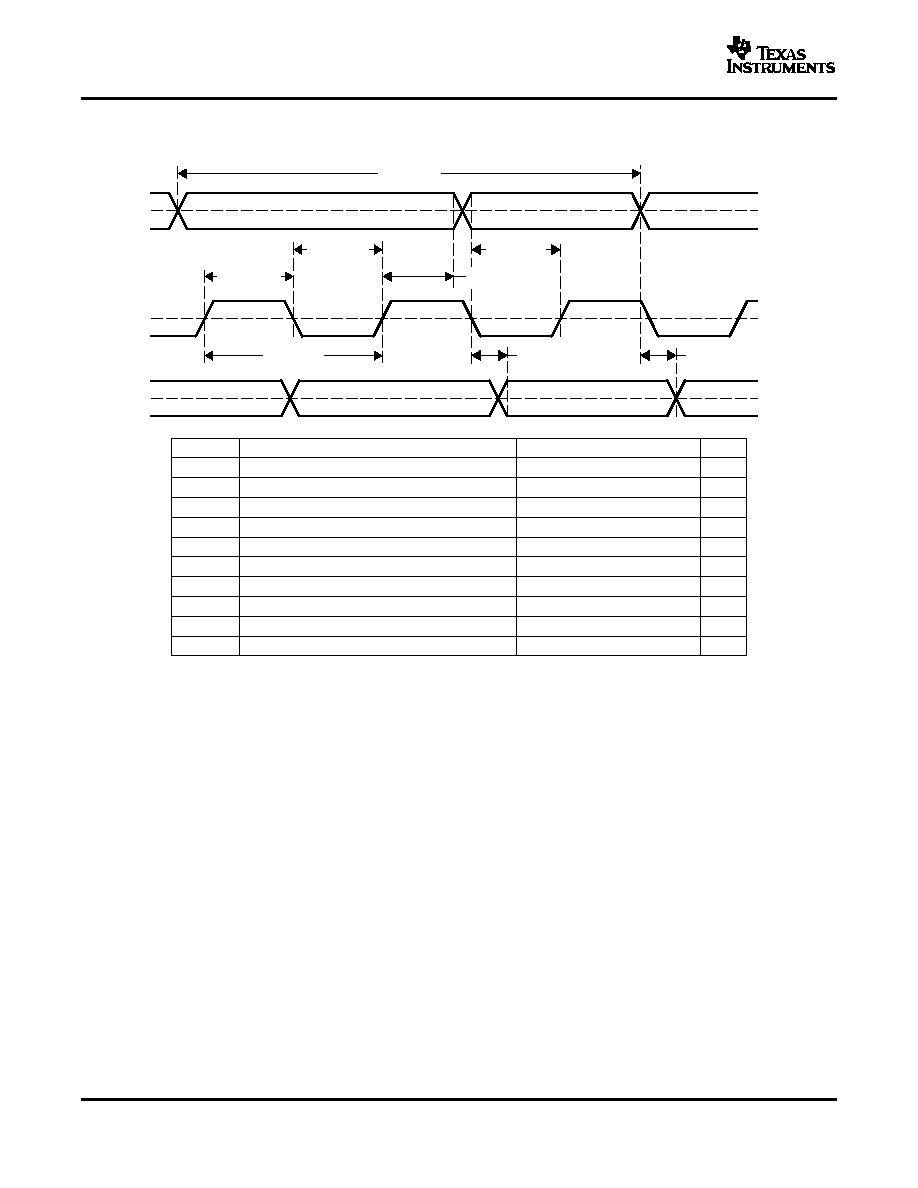
www.ti.com
INTERFACE TIMING
BCK
LRCK
DOUT
t
(BCKH)
t
(BCKL)
t
(LRHD)
t
(LRCP)
t
(LRSU)
t
(BCKP)
t
(CKDO)
t
(LRDO)
1.4 V
1.4 V
0.5 V
DD
T0017-02
PCM1803
SLES125 ≠ NOVEMBER 2004
Figure 20 and Figure 21 illustrate the interface timing in slave mode and master mode, respectively.
SYMBOL
PARAMETER
MIN
TYP
MAX
UNIT
t
(BCKP)
BCK period
1/(64 f
S
)
ns
t
(BCKH)
BCK pulse duration, HIGH
1.5
◊
t
(SCKI)
ns
t
(BCKL)
BCK pulse duration, LOW
1.5
◊
t
(SCKI)
ns
t
(LRSU)
LRCK setup time to BCK rising edge
40
ns
t
(LRHD)
LRCK hold time to BCK rising edge
20
ns
t
(LRCP)
LRCK period
10
µ
s
t
(CKDO)
Delay time, BCK falling edge to DOUT valid
≠10
40
ns
t
(LRDO)
Delay time, LRCK edge to DOUT valid
≠10
40
ns
t
r
Rising time of all signals
20
ns
t
f
Falling time of all signals
20
ns
NOTE: Timing measurement reference level is (V
IH
+ V
IL
)/2. Rising and falling time is
measured from 10% to 90% of IN/OUT signal swing. Load capacitance of DOUT is
20 pF. t
(SCKI)
means SCKI period time.
Figure 20. Audio Data Interface Timing (Slave Mode: LRCK and BCK Work as
Inputs)
14
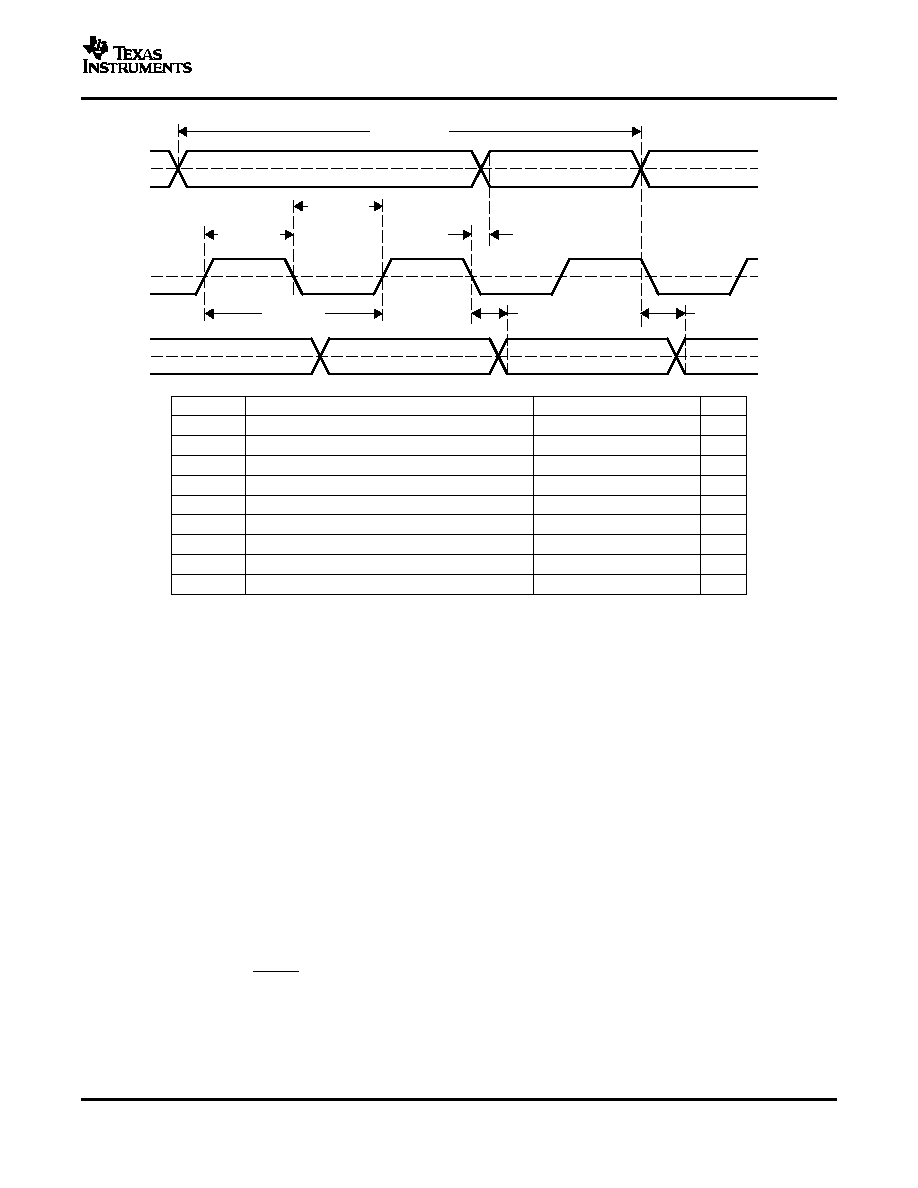
www.ti.com
BCK
LRCK
DOUT
t
(BCKH)
t
(BCKL)
t
(CKLR)
t
(LRCP)
t
(BCKP)
t
(CKDO)
t
(LRDO)
0.5 V
DD
0.5 V
DD
0.5 V
DD
T0018-02
SYNCHRONIZATION WITH DIGITAL AUDIO SYSTEM
PCM1803
SLES125 ≠ NOVEMBER 2004
SYMBOL
PARAMETER
MIN
TYP
MAX
UNIT
t
(BCKP)
BCK period
150
1/(64 f
S
)
1000
ns
t
(BCKH)
BCK pulse duration, HIGH
65
600
ns
t
(BCKL)
BCK pulse duration, LOW
65
600
ns
t
(CKLR)
Delay time, BCK falling edge to LRCK valid
≠10
20
ns
t
(LRCP)
LRCK period
10
1/f
S
65
µ
s
t
(CKDO)
Delay time, BCK falling edge to DOUT valid
≠10
20
ns
t
(LRDO)
Delay time, LRCK edge to DOUT valid
≠10
20
ns
t
r
Rising time of all signals
20
ns
t
f
Falling time of all signals
20
ns
NOTE: Timing measurement reference level is (V
IH
+ V
IL
)/2. Rising and falling time is
measured from 10% to 90% of IN/OUT signal swing. Load capacitance of all signals
is 20 pF.
Figure 21. Audio Data Interface Timing (Master Mode: LRCK and BCK Work as
Outputs)
In slave mode, the PCM1803 operates under LRCK, synchronized with system clock SCKI. The PCM1803 does
not need a specific phase relationship between LRCK and SCKI, but does require the synchronization of LRCK
and SCKI.
If the relationship between LRCK and SCKI changes more than
±
6 BCKs for 64 BCK/frame (
±
5 BCKs for 48
BCK/frame) during one sample period due to LRCK or SCKI jitter, internal operation of the ADC halts within 1/f
S
and digital output is forced to zero data (BPZ code) until resynchronization between LRCK and SCKI occurs.
In case of changes less than
±
5 BCKs for 64 BCK/frame (
±
4 BCKs for 48 BCK/frame), resynchronization does
not occur and the previously explained digital output control and discontinuity do not occur.
Figure 22 illustrates the digital output response for loss of synchronization and resynchronization. During
undefined data, the PCM1803 can generate some noise in the audio signal. Also, the transition of normal to
undefined data and undefined or zero data to normal creates a discontinuity in the data of the digital output,
which can generate some noise in the audio signal.
It is recommended to set PDWN (pin 7) to LOW once to get stable analog performance when the sampling rate,
interface mode, data format, or oversampling control is changed.
15
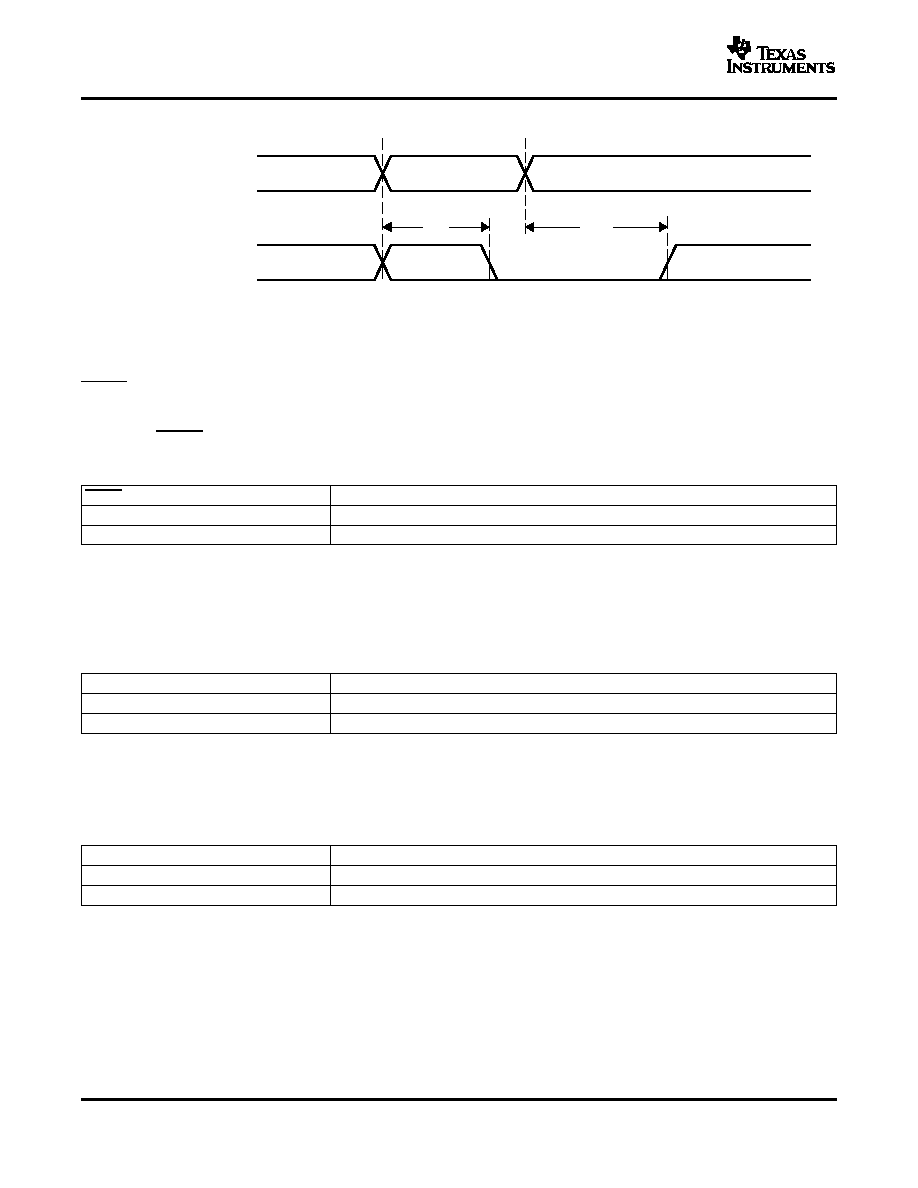
www.ti.com
1/f
S
32/f
S
NORMAL DATA
ZERO DATA
UNDEFINED
DATA
NORMAL DATA
SYNCHRONOUS
ASYNCHRONOUS
SYNCHRONOUS
Resynchronization
Synchronization Lost
DOUT
State of Synchronization
T0020-05
POWER DOWN
HPF BYPASS
OVERSAMPLING RATIO CONTROL
PCM1803
SLES125 ≠ NOVEMBER 2004
Figure 22. ADC Digital Output for Loss of Synchronization and Resynchronization
PDWN (pin 7) controls operation of the entire ADC. During power-down mode, supply current for the analog
portion is shut down and the digital portion is reset; also, DOUT (pin 12) is disabled. It is acceptable to halt the
system clock during power-down mode so that power dissipation is minimized. The minimum LOW pulse
duration of PDWN pin is 100 ns.
Table 4. Power-Down Control
PWDN
Power-Down Mode
LOW
Power-down mode
HIGH
Normal operation mode
The built-in function for dc-component rejection can be bypassed by BYPAS (pin 8) control. In bypass mode, the
dc component of the input analog signal, internal dc offset, etc., also are converted and included in the digital
output data.
Table 5. HPF Bypass Control
BYPAS
HPF (High-Pass Filter) Mode
LOW
Normal (no dc component in DOUT) mode
HIGH
Bypass (dc component in DOUT) mode
OSR (pin 16) controls oversampling ratio of the delta-sigma modulator,
◊
64 or
◊
128. The
◊
128 mode is available
for f
S
48 kHz.
Table 6. Oversampling Control
OSR
Oversampling Ratio
LOW
◊
64
HIGH
◊
128 (f
S
48 kHz)
16

www.ti.com
APPLICATION INFORMATION
TYPICAL CIRCUIT CONNECTION DIAGRAM
V
IN
L
20
19
18
17
16
15
14
13
12
11
1
2
3
4
5
6
7
8
9
10
PCM1803
V
IN
R
V
REF
1
V
REF
2
V
CC
AGND
PDWN
BYPAS
TEST
LRCK
MODE1
DGND
MODE0
FMT1
FMT0
OSR
DOUT
BCK
V
DD
SCKI
+
Oversampling
System Clock
L-Ch IN
R-Ch IN
+5 V
C
4
+
C
5
Power Down
LCF Bypass
Control
+
C
3
L/R Clock
Audio Data
Processor
Mode [1:0]
Format [1:0]
+3.3 V
Data Clock
Data Out
+
C
1
+
C
2
Control
R
1
S0026-01
+
C
6
R
2
C
7
C
8
BOARD DESIGN and LAYOUT CONSIDERATIONS
V
CC
, V
DD
Pins
AGND, DGND Pins
PCM1803
SLES125 ≠ NOVEMBER 2004
Figure 23 illustrates a typical circuit connection diagram where the cutoff frequency of the input HPF is about
160 kHz.
NOTES:
A.
C
1
, C
2
: A 1-
µ
F electrolytic capacitor gives a 4-Hz (
= 1
µ
F
◊
40 k
) cutoff frequency for the input HPF in normal
operation, and requires a power-on settling time with a 40-ms time constant during the power-on initialization period.
B.
C
3
, C
4
: Bypass capacitors are 0.1-
µ
F ceramic and 10-
µ
F electrolytic, depending on layout and power supply.
C.
C
5
, C
6
: Recommended capacitors are 0.1-
µ
F ceramic and 10-
µ
F electrolytic.
D.
C
7
, C
8
, R
1
, R
2
: A 0.01-
µ
F film-type capacitor and 100-
resistor give a 160-kHz (
= 0.01
µ
F
◊
100
) cutoff
frequency for the antialiasing filter in normal operation.
Figure 23. Typical Application Diagram
The digital and analog power-supply lines to the PCM1803 should be bypassed to the corresponding ground pins
with 0.1-
µ
F ceramic and 10-
µ
F electrolytic capacitors as close to the pins as possible to maximize the dynamic
performance of the ADC.
To maximize the dynamic performance of the PCM1803, the analog and digital grounds are not connected
internally. These grounds should have low impedance to avoid digital noise feeding back into the analog ground.
Therefore, they should be connected directly to each other under the part to reduce potential noise problems.
17
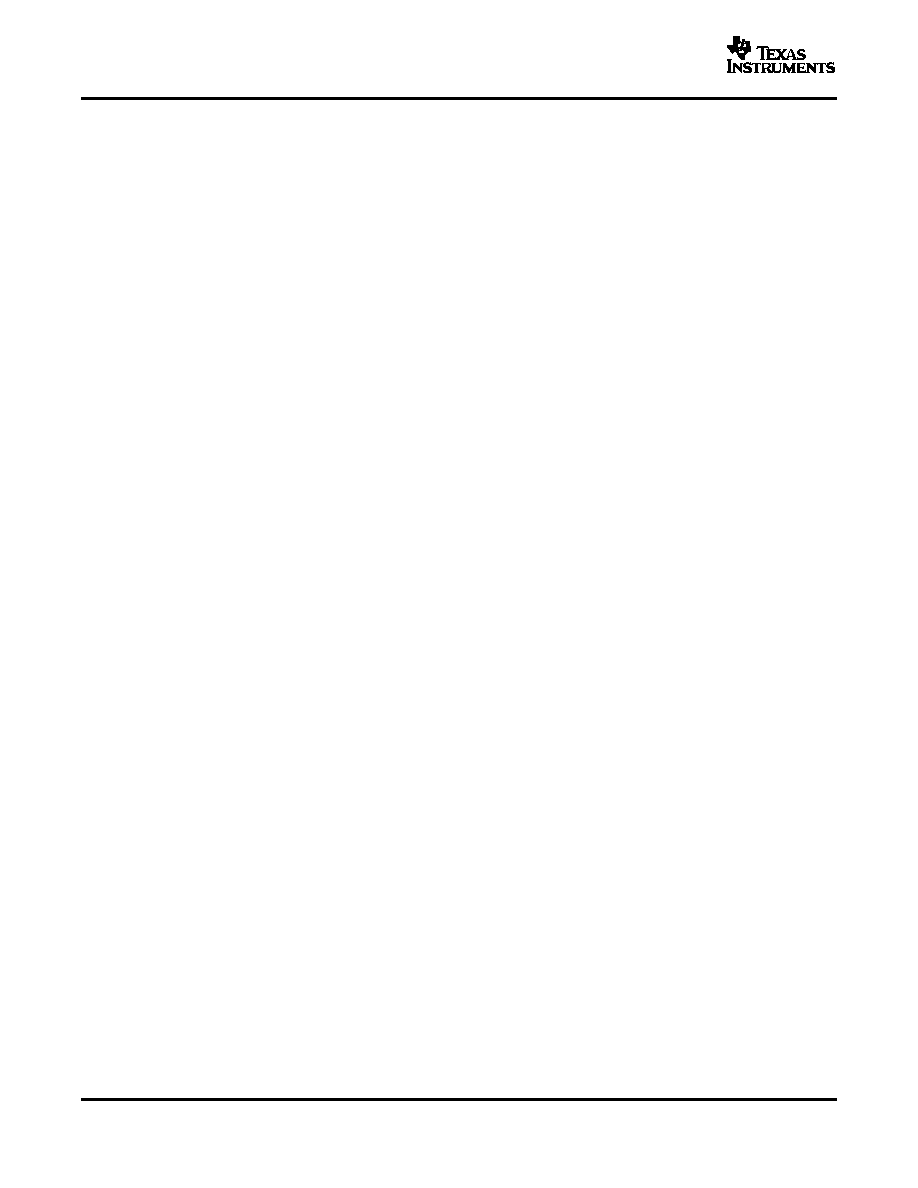
www.ti.com
V
IN
L, V
IN
R Pins
V
REF
1 Pin
V
REF
2 Pin
DOUT Pin
System Clock
PCM1803
SLES125 ≠ NOVEMBER 2004
APPLICATION INFORMATION (continued)
The V
IN
L and V
IN
R pins need a simple external RC filter (f
C
= 160 kHz) as an antialiasing filter to remove
out-of-band noise from the audio band. If the input signal includes noise with a frequency near the oversampling
frequency (64 f
S
or 128 f
S
), the noise is folded into the baseband (audio band) signal through A-to-D conversion.
The recommended R value is 100
. Film-type capacitors of 0.01-
µ
F should be located as close as possible to
the V
IN
L and V
IN
R pins and should be terminated to GND as close as possible to the AGND pin to maximize the
dynamic performance of ADC, by suppressing kickback noise from the PCM1803.
A 0.1-
µ
F ceramic capacitor and 10-
µ
F electrolytic capacitor are recommended between V
REF
1 and AGND to
ensure low source impedance of the ADC references. These capacitors should be located as close as possible
to the V
REF
1 pin to reduce dynamic errors on the ADC reference.
The differential voltage between V
REF
2 and AGND sets the analog input full-scale range. A 0.1-
µ
F ceramic
capacitor and 10-
µ
F electrolytic capacitor are recommended between V
REF
2 and AGND. These capacitors should
be located as close as possible to the V
REF
2 pin to reduce dynamic errors on the ADC reference.
The DOUT pin has enough load drive capability, but if the DOUT line is long, locating a buffer near the PCM1803
and minimizing load capacitance is recommended to minimize the digital-analog crosstalk and maximize the
dynamic performance of the ADC.
The quality of the system clock can influence the dynamic performance, because the PCM1803 operates based
on a system clock. Therefore, it may be required to consider the system-clock duty, jitter, and the time difference
between system-clock transition and BCK or LRCK transition in the slave mode.
18

MECHANICAL DATA
MSSO002E ≠ JANUARY 1995 ≠ REVISED DECEMBER 2001
POST OFFICE BOX 655303
∑
DALLAS, TEXAS 75265
DB (R-PDSO-G**)
PLASTIC SMALL-OUTLINE
4040065 /E 12/01
28 PINS SHOWN
Gage Plane
8,20
7,40
0,55
0,95
0,25
38
12,90
12,30
28
10,50
24
8,50
Seating Plane
9,90
7,90
30
10,50
9,90
0,38
5,60
5,00
15
0,22
14
A
28
1
20
16
6,50
6,50
14
0,05 MIN
5,90
5,90
DIM
A MAX
A MIN
PINS **
2,00 MAX
6,90
7,50
0,65
M
0,15
0
∞
≠ 8
∞
0,10
0,09
0,25
NOTES: A. All linear dimensions are in millimeters.
B. This drawing is subject to change without notice.
C. Body dimensions do not include mold flash or protrusion not to exceed 0,15.
D. Falls within JEDEC MO-150

IMPORTANT NOTICE
Texas Instruments Incorporated and its subsidiaries (TI) reserve the right to make corrections, modifications,
enhancements, improvements, and other changes to its products and services at any time and to discontinue
any product or service without notice. Customers should obtain the latest relevant information before placing
orders and should verify that such information is current and complete. All products are sold subject to TI's terms
and conditions of sale supplied at the time of order acknowledgment.
TI warrants performance of its hardware products to the specifications applicable at the time of sale in
accordance with TI's standard warranty. Testing and other quality control techniques are used to the extent TI
deems necessary to support this warranty. Except where mandated by government requirements, testing of all
parameters of each product is not necessarily performed.
TI assumes no liability for applications assistance or customer product design. Customers are responsible for
their products and applications using TI components. To minimize the risks associated with customer products
and applications, customers should provide adequate design and operating safeguards.
TI does not warrant or represent that any license, either express or implied, is granted under any TI patent right,
copyright, mask work right, or other TI intellectual property right relating to any combination, machine, or process
in which TI products or services are used. Information published by TI regarding third-party products or services
does not constitute a license from TI to use such products or services or a warranty or endorsement thereof.
Use of such information may require a license from a third party under the patents or other intellectual property
of the third party, or a license from TI under the patents or other intellectual property of TI.
Reproduction of information in TI data books or data sheets is permissible only if reproduction is without
alteration and is accompanied by all associated warranties, conditions, limitations, and notices. Reproduction
of this information with alteration is an unfair and deceptive business practice. TI is not responsible or liable for
such altered documentation.
Resale of TI products or services with statements different from or beyond the parameters stated by TI for that
product or service voids all express and any implied warranties for the associated TI product or service and
is an unfair and deceptive business practice. TI is not responsible or liable for any such statements.
Following are URLs where you can obtain information on other Texas Instruments products and application
solutions:
Products
Applications
Amplifiers
amplifier.ti.com
Audio
www.ti.com/audio
Data Converters
dataconverter.ti.com
Automotive
www.ti.com/automotive
DSP
dsp.ti.com
Broadband
www.ti.com/broadband
Interface
interface.ti.com
Digital Control
www.ti.com/digitalcontrol
Logic
logic.ti.com
Military
www.ti.com/military
Power Mgmt
power.ti.com
Optical Networking
www.ti.com/opticalnetwork
Microcontrollers
microcontroller.ti.com
Security
www.ti.com/security
Telephony
www.ti.com/telephony
Video & Imaging
www.ti.com/video
Wireless
www.ti.com/wireless
Mailing Address:
Texas Instruments
Post Office Box 655303 Dallas, Texas 75265
Copyright
2004, Texas Instruments Incorporated



















